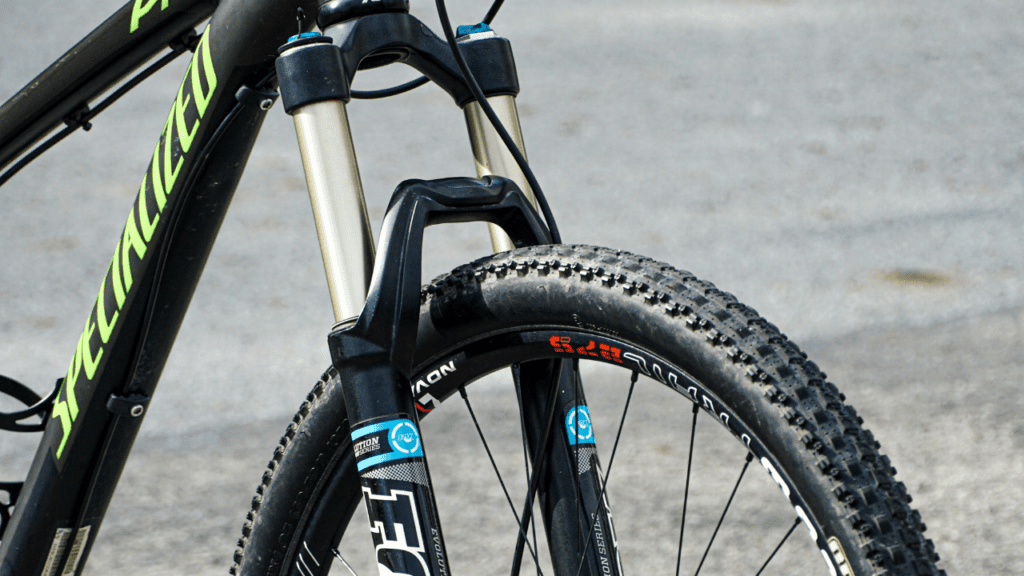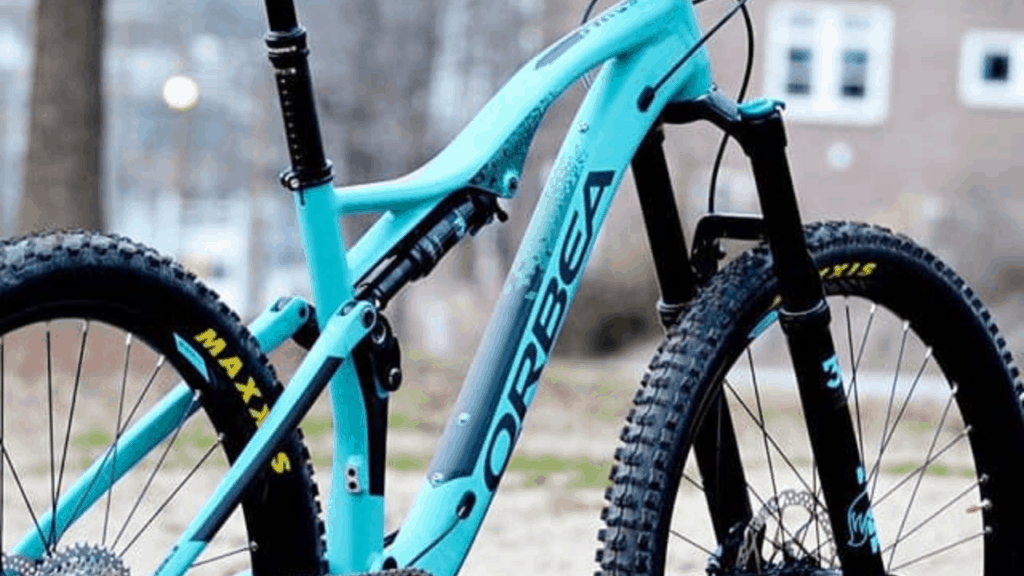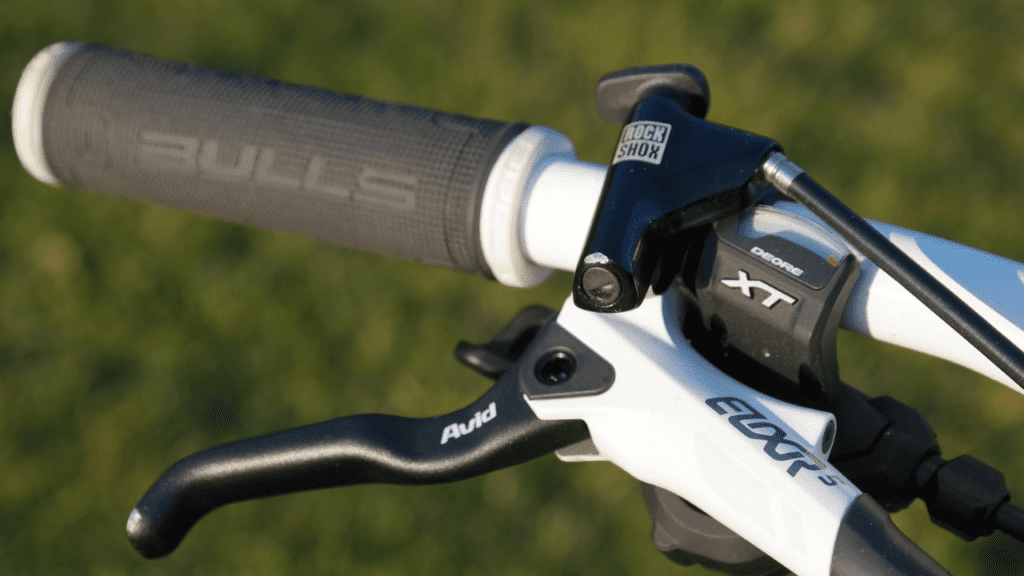What is a Lockout Fork on a Mountain Bike?
/ Beginners / What is a Lockout Fork on a Mountain Bike?
Have you ever thought about or seen a lockout fork on a mountain bike? This lockout mechanism is there to prevent the suspension fork from compressing. But you might ask why there is a need to make those rigid bikes then?
In this post, we will explain why you need a mountain bike lockout fork and why you should look for one. So scroll down to read further and be sure to watch the video at the the end for more details.

What is a Mountain Bike Lockout Fork?
This lockout mechanism is a small switch located right on top of the right-hand side of your front wheel suspension stanchion. When you engage it, it will reduce the low-speed compression rate of your front fork. You can adjust it to a point where your fork becomes fully rigid. You can also route this lockout to your handlebar for convenient access.
What purpose does it serve?
Before we dig deep and understand the purpose of this mountain bike lockout, we must understand the difference between a hardtail MTB and a full suspension MTB. Both MTBs serve different purposes. Therefore, they both have their pros and cons.
Full/front suspension MTBs
A full suspension MTB is equipped with both rear and front suspension systems. An MTB that only has front suspension is called front suspension MTB, and it can benefit from this lockout mechanism. With the suspension in place, your bike can absorb bumps when riding downhill, and your riding experience will become much more comfortable.
However, with full or front suspension, riding your MTB uphill or on pavement, this suspension system will end up absorbing plenty of energy. Therefore, pedaling will become much more difficult on steep inclinations. You will have to put in much more effort to achieve a decent speed uphill on a full or front suspension MTB.
Hardtail MTBs
Hardtail MTBs are not equipped with any type of front or rear suspension. The positive associated with not having any suspension means that the MTB can provide you with an unmatched pedal response. It is because there is no suspension system to absorb any energy from your pedaling. So all your effort is going into the trail. It is going to work very well for a level or uphill terrain.
Nevertheless, these hardtail MTBs are not comfortable to ride on bumpy terrains. You’ll feel all those bumps from the trail while riding. You will find any of those drops are pretty punishing, and large drops become pretty much impossible to land. Unless you are a heck of a rider, riding these hardtail MTBs will only be useful on roads.
Here is where the Lockout Mechanism comes in
As you can see, your full suspensions or hardtail MTBs are not versatile enough to handle all kinds of terrains. So unless you are a specialized rider who will use your MTB on specific terrains, you will have to find a way to make your bike much more lenient on all terrains.
If you want to ride different types of terrains and at different angles, you might have to go for two bikes or go through a punishing riding experience. But neither of these two options seem to be productive. It is where these lockout forks come into play.
With these lockout mechanisms on your full suspension MTB, you can unlock the suspension to make your bike a full suspension MTB and start riding it downhill to absorb those bumps. And when you are riding uphill or on level terrain, you can lock your suspension and make it a hardtail bike to get a maximum pedal response.

Difference Between Compression & Rebound Suspension
There are two ways available to adjust the compression rate of the suspension on your MTB. you can adjust your low-speed compression rate that is going to reduce the compression speed on an MTB. The other way is to go for rebound adjustment, which will influence the decompression rate of the suspension of your MTB.
Some manufacturers like Fox and RockShox use blue color on this switch to denote the adjusting dial for suspension compression. Moreover, they place it right on top of the stanchion. Both these manufacturers also use a red switch for rebound adjustment.
But Rockshox uses directional indicators for both options. The farthest left is open suspensions. When the switch is in the middle, your compression is adjusted, and it will be fully locked when it is farthest to its right. Fox’s compression dial also features a directional indicator. But they have labeled their compression dial with Firm, Medium, and Open.
The rebound dial that Rockshox has is labeled with a turtle and a jackalope. It indicates the directionality of this switch. For example, towards the jackalope, your compression will be open and more closed towards the tortoise.
This switch is a bit more complicated on Fox, and it is labeled with Plus and Minus, indicating the rebound suppression. “Plus” means more suppression, and “Minus” means less suppression.
Remote lockout fork
A remote lockout option is also available; for example, you can go for Chooee remote lockout fork. You can control it using a dial that is present on the handlebar of your MTB. The merit of having this remote lockout is that you will not have to get off your bike and engage this lock.

On a trail that has more variety, this remote locking feature will be handy. You can conveniently engage and adjust the compression of your suspension system for your handlebar. You can even install this lockout mechanism for your rear suspension.
Is this rear lockout system ideal for MTBs?
On full suspension MTBs, you have a suspension system on your front and rear end. Therefore, you can install this lockout switch on your front or your rear wheel. These switches use three-step dials for adjusting the low-speed compression or a rebound adjustment.
But unlike the front fork lockout, the rear fork lockout can inhibit hill climbing at times on rough terrain. But a rigid rear shock is not going to improve your dining experience uphill or on the pavement. It happens because the rear end absorbs most of the energy from the high speed.
Functioning of these lockout and rebound adjustments
These rebound and lockout systems work when they use pressurized oil for changing the compression or decompression speed. A lockout system that is completely disengaged will let oil quickly flow right through the chamber.
Whereas fully locked suspensions entirely restrict this oil flow. Similar is the case with rebound adjustment systems. But instead of using positive pressure, this system uses negative pressure to affect the rate of decompression.
Do Riders use Lockout Suspension?
On paper, this lockout suspension switch seems to be a mouthwatering feature for versatile riders who like to ride all kinds of terrains. But this feature does not come cheap. So if you’re concerned about how practical it is to have this feature on your bike, it is completely understandable.
But if you do some research, you will see many riders in favor of this switch and an equal number of riders against it. So it can make things pretty confusing as to whether you should go for it or not. But if you go deeper in your research, you will find out why so many people do not use these lockout suspension switches.
- Most people say that they forget to turn it off. And if you keep it engaged, it can be a problem when in the middle of riding trails and worsen things if there are a few descents. It might seem that this fault is completely associated with the rider, but many people have to deal with this problem.
- Another complaint people have with this lockout mechanism is that they do not notice much difference when engaged or disengaged. But if you have an MTB with a low travel distance, you might not notice much difference in power transfer.
- Most people think that this lockout feature is much more useful if it is remote and is routed on MTB handlebars. Many riders have felt the inconvenience of getting off the bike and stitching the suspension on and off.
To conclude, you can say that to justify the high price tag. You need to go for the remote switch lockout. Apart from that, you also need to use your bike in a region where you can ride different terrains and inclinations. Otherwise, these lockouts are not going to be very useful.
Do These Lockouts/Rebound Adjustments Replace Hardtail MTBs?
No, these lockouts and rebound adjustments might seem like they are a good replacement for those hardtail MTBs, but they are not. All MTBs serve their purpose. Full suspension MTBs are for tough and rough terrains. Hardtails are for smooth flatter terrains and uphill rides.
Lockouts can mimic the feel of a hardtail ride, but there is a significant difference. Moreover, the presence of a suspension system adds more weight to your bike, and you will have to spend more time on maintenance with added parts.
But a full suspension MTB that features a lockout/rebound adjustment is the best available form of a DH trail bike. It can function well on both uphill and downhill trails and can make your pavement rides pretty comfortable too.
Be sure to watch this video for more insights on lockouts for your bike.
Final Word
A Lockout fork on a mountain bike can be pretty useful. They allow you to go for a ride on downhill terrains, uphill and ride flatter terrains. But the thing is that you should go for a remote lockout switch on your handlebar.
The one that is located on your stanchion is not going to be very handy. You will have to get off your bike and make the adjustment. With the remote switch, you will not have to get off your bike, and you will not often forget about turning it off or on while riding different terrains. But having this feature on your MTB will make it much more convenient for you to ride different terrains easily.
However, having a mountain bike lockout fork will not make much of a difference if you prefer to ride specific types of terrains more (uphill/flat or downhill). Plus, you will end up dealing with a high price tag too.
Related Articles
What Are Mountain Bike Rock Gardens?
Oli L • September 5, 2022
So you're getting into mountain biking and not sure what mountain bike rock gardens are. Riding rock gardens on a mountain bike is a skill to learn when you first start riding. You might have thought that most trails will be smooth and easy to navigate through but remember that each trail is different. Preparing for these obstacles will help you become a better mountain biker. Rock gardens can come...
The Full Suspension Vs. Hardtail Debate Continues
Oli L • August 28, 2022
The full suspension vs. hardtail debate continues as we look at the pros and cons of each type of bike. Both full suspension and hardtail mountain bikes are great options if you want to start mountain biking. But what do you really need to know about each type before buying one? Mountain biking has exploded in popularity in recent years. The sport involves riding through singletracks mostly in beautiful mother...
6 Mountain Bike Maintenance Tips For Beginners
Oli L • August 8, 2022
There are many different types of mountain bikes out there. But, they all have one thing in common – ongoing maintenance. Mountain bike maintenance can be tricky if you don’t know what you’re doing, you could end up damaging your bike or even yourself. Mountain bikes require proper maintenance to keep everything running smoothly. In this article, we'll show you what to do when things go wrong as a beginner...
8 Steps To Becoming A Better Mountain Biker
Oli L • June 13, 2022
Mountain biking is an activity that requires skill, strength, endurance, and balance. It’s also a great way to stay fit and enjoy the outdoors. But before you hit the trails, there are a few things you need to know to become a better mountain biker. The activity requires both strength and skill. It’s also a sport that has become increasingly popular in recent years. To improve your riding skills, you...
5 Mountain Bike Racing Tips for Beginners
Oli L • June 10, 2022
Mountain bikes are becoming increasingly popular in recent years. They offer an exciting way to explore the outdoors. It also offers many physical and mental health benefits on top of the friendly competition that many enjoy. We're going to go over 5 mountain bike racing tips for beginners to help you get going. MTB racing is an exciting sport that combines speed, agility, and strength in a way that few...
Latest Articles
Popular Articles
Product Of The Week
Monday 12th May
